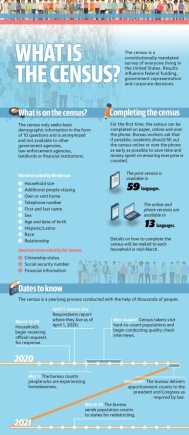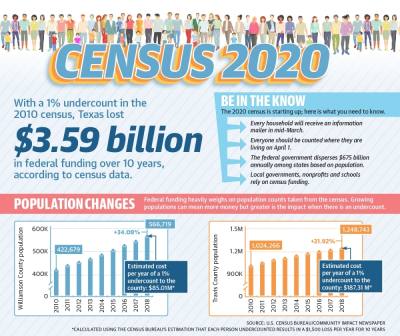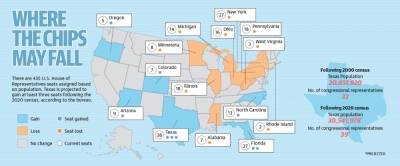Texas lost an estimated $3.59 billion in federal funding due to an undercount in the 2010 census, pushing local municipalities and nonprofits to rev up participation in the coming census, according to census data.
The census is a constitutionally mandated survey that is taken every 10 years to count each person where they live on April 1. The first census took place in 1790 and is only used for data-gathering purposes, said Douglas Loveday, senior media specialist for the U.S. Census Bureau. The distributed census is confidential and anonymous, he added.
The results are then used to determine federal funding allocations, government representation at the federal and local levels, and corporate decisions, all of which could have major impacts on residents, Loveday said.
“These funds come to the state of Texas for programs, but they also trickle down all the way to the local level,” Loveday said.
Money
Every year, the federal government distributes $675 billion to states based on population, which is then divided among state programs, municipalities and local nonprofit organizations, Loveday said. In 2016, Texas received $59.41 billion through 55 federal spending programs guided through 2010 census data, according to the Census Bureau.
The Census Bureau also believes it undercounted Texans by 239,500 people in the last census. At $1,500 per person per year, an estimate given by the bureau, the state lost billions in federal funding that goes toward several programs including subsidized school lunches; the Women, Infants and Children nutritional program; the Supplemental Nutrition Assistance Program; the Head Start program for low income children under 5; student and housing loans; and infrastructure and transportation projects, Loveday said.
John Lawler, census program manager in Travis County, said that while the national per person funding average is $1,500, he suspects the dollar amount associated with an undercounted person will be higher in counties such as Travis and Williamson because of the tremendous growth they are experiencing.
“Folks don’t realize that there's a lot of the federal funding that goes to pay for those things, and unfortunately, in a lot of our neighborhoods, there are a lot of kids who depend on these school lunches,” Loveday said. “If there would be any kind of decrease in the money coming in there, the local school districts may not have enough money to pick up that slack.”
Funding is also distributed to local nonprofits and organizations that residents may rely on such as the Williamson County Children’s Advocacy Center; Travis County Health and Human Services and Veterans Services; CASA in Travis and Williamson counties; and United Way in Greater Austin and Williamson County.
Katie Martin Lightfoot, a census community engagement coordinator for the Center for Public Policy Priorities, said that with just a 1% undercount, Texas stands to lose hundreds of millions of dollars, which could go directly to supporting local organizations, businesses and community health centers that may heavily depend on that funding. In 2010, the Texas population was reported to be about 25.15 million people, which resulted in a 0.95% undercount, according to census data.
Martin Lightfoot said that even if nonprofits and local organizations received less funding, their programs still have to find a way to function for those who use them.
“[The burden] will fall upon the state of Texas or on local governments or the philanthropic or nonprofit communities to make up that need,” Martin Lightfoot said.
Williamson County Judge Bill Gravell said, following the 2010 census, Williamson County received about $1.2 million annually for community block grants, which went toward increasing access to affordable housing, decrease in homelessness and fair housing projects, according to the county website.
“An accurate census is really important for the next generation,” Gravell said. ”Every federal dollar coming back to the community for the next 10 years will be decided in the next [five] months.”
Power
With an accurate count, Texas is expected to gain at least three seats in the U.S. House of Representatives, jumping from 36 to 39, the second most in the country after California with 53 representatives. In 2010, Texas gained four seats.
Once the data is approved, the census is dispersed to state governments and used by legislators—primarily the party in power—to determine redistricting. For Texas, legislators will tackle redistricting in the 2021 session.
While Travis and Williamson counties, which are both seeing high growth patterns, have the potential to gain their own congressional representatives, the party in control of drawing the boundaries may still have an incentive to break populous centers up into multiple districts to dilute the voting power.
Currently, Travis County is split among five representatives, and Williamson County’s one representative is shared with Bell County.
Lawler said redistricting does not only affect state representation but also lines for city council and school board districts. These representatives make decisions on how tax dollars are spent, which schools close, transportation needs and land development plans, among other major decisions.
“This data is going to affect redistricting within the state,” Loveday said. “That is handled by the state Legislature, but the data that they are going to do that with is provided by this 2020 census.”
Business
Lastly, census data has the ability to influence business decisions and dealings, said Sarah Ortiz Shields, Austin Tech Alliance executive director.
She added that where businesses decide to build has a ripple effect into the local economy, impacting the amount of sales taxes an area can collect, job creation, and city and county planning. It may lead to the need for additional roads and infrastructure, she said. And because the census is only taken every 10 years, the impact can be significant.
“Business owners can consult that census data to understand where to open a new location or where cities are expanding,” Ortiz Shields said. “[The census results] are going to drive business decisions for years to come.”
Completing the census
For the first time, the census can be completed online and over the phone in 13 languages, including English, as well as on paper in 59 languages including English, Loveday said.
Loveday said the Census Bureau is emphasizing online and phone responses because of its ability to save time and money. To help in the census efforts, the federal government is looking to hire more than 9,000 employees in Travis County and nearly 4,400 employees in Williamson County. A majority of those positions are for census takers of nonrespondents, Loveday said.
In 2010, 73% of Travis County and 78% of Williamson County voters self-responded by phone or mail. Federal employees are required to track down any remaining residents via knocks on the door or continuous mail-in reminders, which adds the cost of additional printing and postage, he said.
Postcards with directions on how to fill out the census will be mailed to every home beginning March 12. It should be filled out according to who is living in your home on April 1 and who lives there for most of the year. For example, if a college student is not living at home, they should be counted on their college campus, not in their parent’s home, Loveday said.
All children, including newborns, should also be counted, he added.
The census has been delayed two weeks due to the coronavirus and health concerns for census takers, census officials said in a March 23 news release. Census takers are paid federal employees who knock on nonresponders' door to encourage completion of the census. They will now begin going door-to-door in late May, with counts finalized in August. In December, final counts will be signed off by the president and distributed to states for local redistricting as previously scheduled.
“The more people we can get to self-respond—and you get taken out of the system so you won’t get the knock on the door—but that’s less folks that the federal government will have to hire and it's just going to save money, so really we’re encouraging people to self-respond online,” Loveday said.
Ortiz Shields said everyone should complete the census because it takes minimal time and only helps their community.
“You're going to go online; you're going to be on your phone; and you're going to fill something out that's going to take less than five minutes,” Ortiz Shields said. “It's going to help your community, [and] it is anonymous, so there's no real reason not to participate.”








